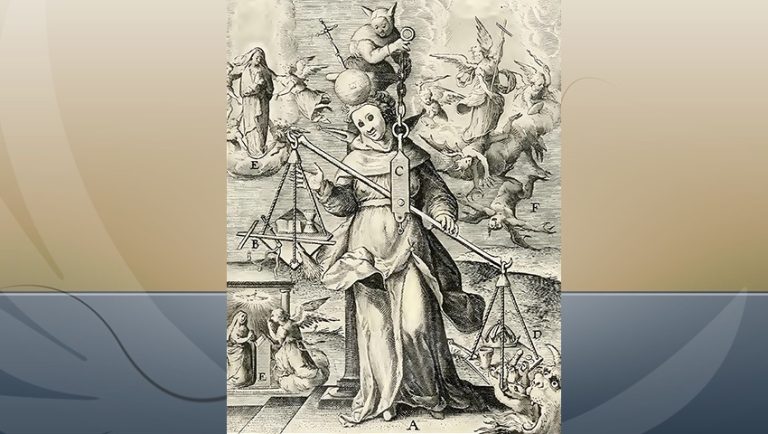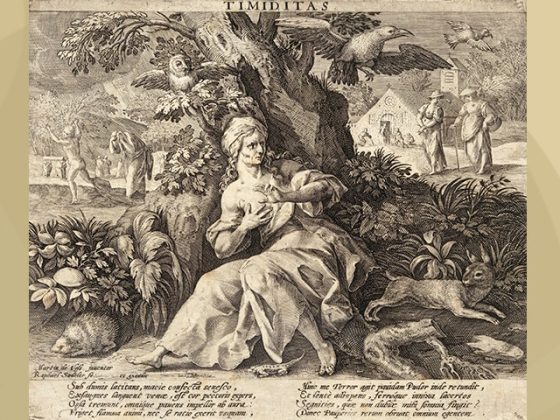Esteemed readers:
On this occasion I am sending you an emblem ─engraving─, Nº 45, of a book entitled Veridicus cristianus, ‘true Christian', the first book of Jesuit emblems, written by Jan David (1545-1613) and published for the first time in Antwerp in 1601 by Jan Moretus (1543-1610).
The title of this engraving is…
…MVNDVS DELIRANS, NON SAPIT, QVAE DEI SVNT
─'The delusional world does not know that there are Gods'─

At the bottom of this engraving we have the following phrase in Latin:
”At nonne hos Mvndvs, mera ceu ludibria, spernit?
Delirat: nec vera videt: nec iudicata aequa.”
Translation:
‘And is it not true that Mundus[the world] rejects them as mere mockery?
Being delirious: it neither sees the truth, nor judges justly'.
The comment of some researchers tells us:
“Published as a tool for devotion and meditation, it has one hundred chapters that cover a wide range of topics for reflection. Each chapter focuses on an emblem consisting of three parts: motto, image and epigrams ─in Latin, Dutch, and French─ and incorporates an extensive commentary interpreting the emblematic image.
Emblem 45 is part of an extensive analysis of the Eight Beatitudes in which the main protagonist is the central figure labeled “A”, Mundus ─the World─. The epigram focuses on the actions and attitude of Mundus.”
Text in French:
“Toutefois la race, Du mondain rechasse, Et hait ceste voix.
Le Monde radotte, Et son humeur sotte, N'entend pas ces loix.”
Translation: ‘However, the race rejects the worldly and hates this voice. The world keeps chattering and its foolish humor does not understand these laws'.
Moving on to the engraving of our study, we will say that the things that Mundus despises are the Eucharistic instruments ─book and chalice─ and arma Christi, or the instruments of the passion ─scourge, whip and cross─, which are labeled as “B” on the left plate of the scales.
Mundus does not intend to grasp any of these instruments, as his gesture with his open right hand clearly shows. While with his left hand he pushes down the container on the right, indicating his preference for its “heavy” contents: crown, scepter, cup, dice, coins and money bag, labeled with “D”. The greedy demon that emerges from the mouth of hell to seize these objects echoes the gesture of Mundus to reach out and grasp worldly things.
The fact that the central figure of this engraving is nothing more and nothing less than the representation of the sleeping humanity is interesting. The word persona in Latin translates as ‘mask', and, indeed, our person and our personality are an egoic mask, something that has no transcendent reality, that is, the absence of the BEING.
Above that central figure we can easily observe a character dressed in the style of clowns. And, curiously, it is he who holds the scales with its two plates, which in turn contain the egoic and other Eucharistic instruments. This character is, without a doubt, the PLURALIZED EGO, the MYSELF that every person carries within and that constitutes the misfortune that does not allow us to have a sacred individuality. Because of this we are simply a bunch of ten thousand very unpleasant psychological aggregates that keep us dazed with the sabotage that they provoke in our psyche. That is the reason why this character is placed on the head of the figure we call Mundus.
In the lower left part of our engraving we must point out the scene that shows us the Angel Gabriel in those moments in which the Sacred Scriptures speak to us of the visitation. That is, when Mary ─the Divine Mother─ is visited by the angelic entity to announce that she would be the mother of the Messiah ─namely: Jesus─. Obviously, this is an allusion to the drama that all Gnostics aspire to live in our heart, that is, the advent of the Christ child in the womb of our blessed Stella Maris ─Hindustani Devi-Kundalini─. This is marked with the letter “E”.
It is also frightening that Mundus ─the world, humanity─ is more inclined, or more appreciative, to the things that constitute the egoic fantasy ─scepters, crowns, money, cups, purses, dice, etc., etc., etc.─ instead of longing to approach the Christic world. And as we see in our engraving, all the things that constitute our worldliness are attracted by our own inner Satan, for he lives from that, by that, in that and for that; in other words: to shape his kingdom in the tartarus of involution. That is why the representation of hell is a huge open mouth ready to devour the sleeping souls, as Gnosis so well tells us.
In the upper left part we then see Mary ─Devi-Kundalini─ floating and flanked by four guardian angels. It is undeniable that the divine Eternal Feminine has angelic forces surrounding Her, for She is precisely the Mother of all the Adepts who have attained this divine state. Nature attracts nature, Alchemy tells us; that is, things attract each other according to their own nature; the divine attracts the divine, the malefic attracts the infernal, that is the law.
Among the Christic instruments we must highlight some details from the Gnostic point of view:
- The chalice or holy yoni that is never lacking in the lives of the self-realized Adepts.
- The whip, an instrument that allegorizes voluntary suffering and conscious sacrifices.
- The cross, which represents not only the terrible crucifixion proper to the mysteries of the Second Initiatic Mountain, but also the sacred crossing of the lingam-yoni of the Tantric mysteries; the key that, precisely, takes us to the steps of the Christic states.
- The open Bible, which allegorizes the fact that we are constantly nourished with the doctrine of regeneration.
On the other hand, in the upper right part of our illustration we observe angels or Adepts of Light expelling demonic entities into the abyss. Two of these angels carry shields ─an allegory of prudence─ and flaming swords, and a third one carries with him a cross that has a spearhead, with which he also expels demonic entities into the infra-dimensions of Nature ─namely: hell─. This is marked with the letter “F”.
I now send you some phrases that deserve to be reflected upon:
“Eternity breaks all measure and destroys all comparison.”
Pierre Nicole
“Hold on to the present. Each situation, each moment, has an infinite value because it represents an eternity.”
Goethe
“Eternity: a day without yesterday or tomorrow”.
Massilon
“Most men who do not know what to do with this life want another one that never ends.”
Anatole France
PERFER ET OBDURA.
─'Endure and resist'─.
KWEN KHAN KHU





